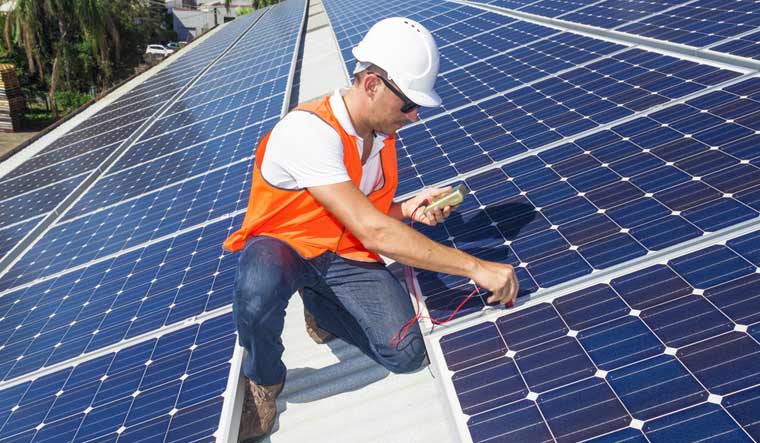India’s push for solar as a viable power source will get a shot in the arm as Prime Minister Narendra Modi inaugurates one of the largest solar parks in the world in Madhya Pradesh’s Rewa on Friday. It will have a capacity of 750MW.
With the fact that solar energy auctions last week threw up the lowest bid ever, at Rs 2.36 per unit, analysts are reading it as an inflection point for a future solar energy boom in the country. The lowest previous rate was 2.44 in 2018.
“COVID-19 fails to halt the aggressive renewable energy growth story,” exulted Union power minister R.K.Singh after the completion of the auction. The fact that half of the 2,000MW on auction was bagged by companies from abroad like Spain’s Solarpack and Italy’s Enel has left government officials thrilled. It comes in the backdrop of the government making it clear its intention to restrict Chinese presence in the sector.
Cheaper solar power means cheaper power for commercial and industrial purposes, which will make India an attractive destination for foreign investment — presently charges for commercial usage of electricity averages around Rs 8 per unit (varies from state to state). The government’s hope is that once cheaper sources of solar power become operational, it could be brought down to around Rs 5.
That is where projects like the one in Rewa which the PM is inaugurating come in. “This is India’s first solar project to conduct inter-state sale of electricity with its power purchase agreement accepted by the Union government as a standard model to help achieve the lowest electricity tariff rates through competitive bidding,” points out Amit Jain, senior energy specialist at the World Bank, which funded the project.
Delhi Metro has been sourcing electricity from Rewa, and the new project is set to bolster the public transit system’s cost savings.
In fact, many states have been looking at solar to cut energy costs. Odisha is aiming at increasing its solar capacity to 1500MW in a couple of years. Punjab is hoping that the PM-KUSUM, a 10GW grid scheme to solarise agriculture pumps to be launched next year will help cut its massive expenditure on subsidised electricity to farmers. The state spends more than 16,000 crore rupees on power subsidy every year.
Indian Railways is installing solar power plants in vacant land, with an aim to make the state-run rail network ‘net zero’ carbon emission by 2030. The projects include those in Raebereilly (UP), Bina (MP), Bhilai (Chhattisgarh) and Diwana (Haryana), which, once commissioned, will run overhead traction lines, saving crores of rupees in energy cost to the Railways. Power from the Bina installation is expected to be operational by next week.
Of course, the government’s big solar initiative does face a formidable hindrance — the China factor. A vast majority of the photo-voltaic (PV) ‘solar panels’, not to mention other infrastructure equipment, are dependent on China. Last year, India’s power sector imported Rs 70,000 crore worth of gear from abroad, a good chunk of it from China.
But now post the Galwan clash and the bugle cry for ‘Atma Nirbhar Bharat’, there is a scramble to find alternatives. The government itself will implement from next month the budget proposal of imposing 20 per cent customs duty on imported solar panel. This will go up to 40 per cent next year. Duty on solar cells will be 15 per cent now and up to 40 per cent next year (Though there is a proposal to exempt firms which have power purchase agreements with procuring states). Stricter quality specifications and limiting govt funding for projects using Chinese equipments are also on the anvil.
Another effort is to wean away Indian power companies, both public and private. According to a power ministry report, all but five or so critical items used for generating, transmitting and distributing power is available locally. Yet, they are generally imported from China since it tends to be cheaper. PSUs like Coal India and Neyveli Lignite Corporation have also announced joint ventures to develop solar assets.
CRISIL Research estimates prices to fall further led by the oversupply and fall in global demand, which should help lower capital costs further. Solar is surely a sunrise sector, if there ever was one.



